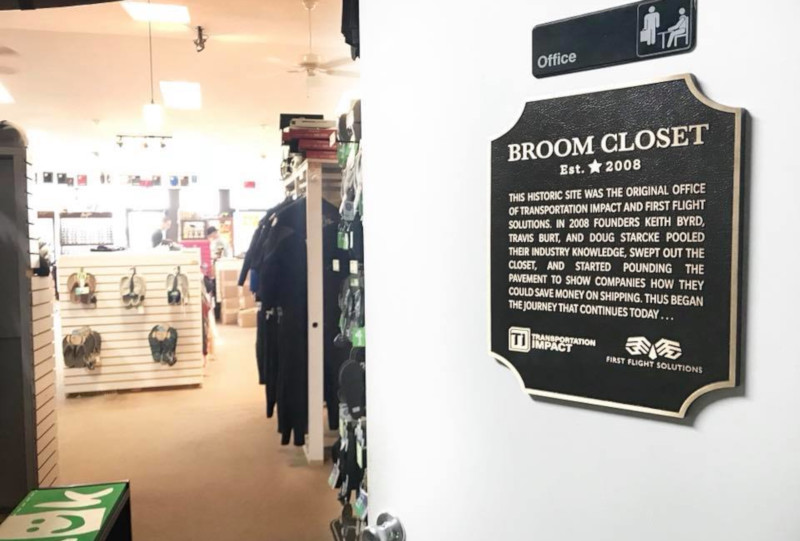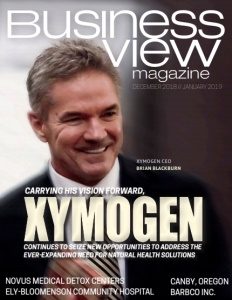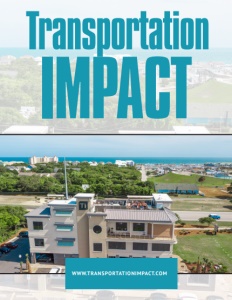Transportation Impact
Helping high-volume shippers
Business View Magazine interviews representatives from Transportation Impact as part of our focus on logistics management companies.
When a company that started in the broom closet of a North Carolina surf shop in 2008 can boast, ten years later, of having made the Inc. 5000 Fastest-Growing Companies list six years running (and Inc.’s Best Workplaces twice), with projected 2018 revenues of $40 million and customers like Georgia-Pacific, NASCAR, Tiger Direct, and Subway, it’s clear this Emerald Isle, North Carolina, business, a supply chain spend management company that provides small parcel negotiations and freight management, has been riding a big wave.
Transportation Impact was co-founded by friends Keith Byrd and Travis Burt in 2008. Both had worked at UPS (Byrd, 20 years; Burt, 23 years) as executives, negotiating pricing agreements on behalf of the carrier. “We thought one day how good this would be if we were working directly with the customers,” says Byrd. “The carrier would still be profitable, but we would get paid from the savings we’d generate. We took our knowledge, skill, and ability and built this business. So, fast forward ten years, we have about 85 employees, almost 700 customers, and we’re really having a great time at doing this.”

Keith Byrd (L) Travis Burt (R)
As a non-asset-based company, Transportation Impact doesn’t move packages, so it doesn’t compete with UPS, FedEx, or other carriers. Transportation Impact helps high-volume shippers with three things, as Byrd describes: “First, we help them negotiate a better pricing agreement with the carrier, and we only get paid by sharing in the savings we generate. Second, we conduct ongoing invoice-based audits. So, if a guaranteed package arrives late, our home-grown technology goes out and secures that refund on behalf of the client. We also give them a best-in-class dashboard that provides business intelligence to help run their business better from a supply-side perspective. Third, there’s our new freight division, where we provide a TMS (Transportation Management System) to automate the many manual parts of every logistics operation — printing bills of lading and shipping paperwork, communicating with carriers, and managing freight invoice audit.
“About four years ago,” Byrd continues, “we had 400 customers that already trusted us coming to us saying, ‘Hey, you helped us so much with our UPS and FedEx, is there any way you could help us with our LTL and truckload?’ We figured we were sitting on a gold mine, and that’s when we expanded into freight services and offering a TMS. We didn’t know anything about that then, because we were UPS small parcel people. So we hired a best-of-the-best team to go to market on the freight side.”
Byrd says that many customers first get in touch with the company via its small parcel audits. Seeing success in securing refunds leads to rate negotiations for better pricing. “Another channel to market is we go to over 30 trade shows each year and meet CFOs, face to face, to pitch our sermon,” he adds. “Our main channel is references. When you’re saving a CFO $800K per year it doesn’t take long, with the circles they run in, for one to say, ‘Hey, would you go help my buddy in Michigan?’ It’s truly humbling when a CFO tells you that because of what you did, you have saved jobs.”
Though there are a few competitors that do essentially what it does, Transportation Impact does possess some competitive advantages, including the willingness to practically give away its initial work to secure long-term business. “First, we do a free analysis for a large-volume shipper to get them every bit of savings available,” says Byrd. “We count on losing a customer after our initial turn on the small parcel side. If we do our job right, and take that operating ratio to the brink, to where the carrier is still making money, our customer should never need us again. We go for broke the first time, and we guarantee the savings in writing. If we don’t achieve what we guarantee, we don’t get paid.
“The second advantage we have,” he continues, “is our skill set. We’ve surrounded ourselves with very good people. When we first started, we thought we had to hire a bunch of 20-year former UPS or FedEx sales people. We found out very early that’s not the case at all. We’ve got 28-year-olds who’ve never worked for a carrier making huge decisions. But Millennials add a lot of value and knowledge, a lot of creativity, plus listening skills and attention to detail. We live in a little community of 4,000 on the coast of North Carolina. For us to hire the quality of people we do is fortunate, and our retention rate is high.
“And then the third thing that really differentiates us, on the freight side, is that we are a disrupter. Among our negotiation and audit competitors, nobody is offering a TMS as part of their service.”
Burt adds, “We’ve invested heavily in our software platforms. We started off with a pen and paper and calculator for determining the savings and measuring the results. With the next iteration of the invoicing and analysis platform, we’re going to increase our capabilities to ten times from where we are today. We’re now a technology company that has a shrewd and strategic sales force, as opposed to the strong negotiators with pencil and calculator that we were a decade ago. Three or four years ago we adopted a management philosophy called ‘Traction’ or EOS (Entrepreneurial Operating System) to laser-focus our priorities for growing our business.”

“Through our technology, we’re creating ‘stickiness’ with our customers,” notes Byrd. “Not just by calculating how much the freight is, but by showing them who their profitable customers are and having visibility into their data. People love business intelligence, and we have really built a business intelligence technology platform that separates us from any competition.” Going forward, Byrd asserts that technology will continue to be the company’s main priority. “And we want to do internationally what we now do domestically,” he adds.
Transportation Impact also will continue to make an impact on its community. “UPS taught us a valuable lesson,” Byrd remarks in conclusion. “We give back to our community, not just in money but also in time and effort. We pride ourselves on giving back. Through our ‘IMPACT1’ initiative, which we launched in 2017 to formalize and expand our philanthropy, our people are paid for volunteering 20 hours a year, and we also give back one percent in both profit and in-kind services.”
Check out this handpicked feature on SiteWise, LLC – A leader in utility infrastructure.
AT A GLANCE
WHO: Transportation Impact
WHAT: A supply chain spend management company
WHERE: Emerald Isle, North Carolina
WEBSITE: Visit Website





